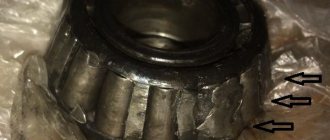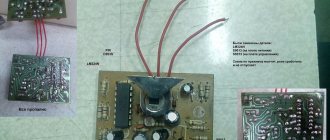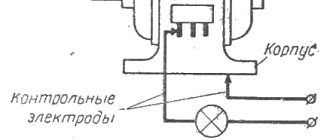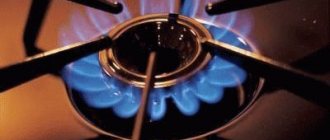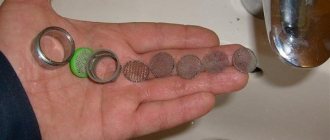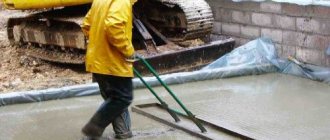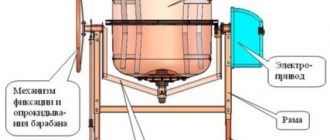Any builder strives to acquire this equipment, but without knowing the operating principle of a concrete mixer, he faces a number of problems. It doesn’t want to start, it starts to buzz, and other similar troubles can await an inexperienced worker. In this article we will look at how to overcome all the difficulties and learn how to make repairs so that the concrete mixer can continue to work for a long time and reliably.
Design and principle of operation
Regardless of the manufacturer and operating principle, all concrete mixers have one goal - to prepare mixtures and solutions that are necessary for various construction works:
- pouring the foundation;
- bricklaying;
- laying tiles, etc.
Such a construction machine increases work productivity, reduces time, and also provides higher quality of the finished mortar. Like any mechanism, a concrete mixer requires attention and timely maintenance.
Any concrete mixer consists of such basic structural elements as:
- drum in which the solution is mixed. It comes in various shapes (cylindrical, barrel-shaped, pear-shaped);
- frame – support for all equipment (left and right support, traverse, mechanism for fixing the tipping of the drum). All parts are attached to it;
- blades - they are the ones who mix the concrete. Another function of the blades is to prevent solutions from sticking to the drum wall;
- drive unit. It is responsible for the operation of the stirrer. Includes a transmission mechanism and its control system.
According to the type of mixing process, concrete mixers are:
- manual, in which the rotation of the barrel occurs due to the twisting of a special handle by the employee;
- driven - the mechanism starts after turning on the desired button and is powered by electricity or fuel (diesel or gasoline).
According to the principle of operation, concrete mixers are divided into:
- gravitational: in a rotating drum the mixture rises and falls under its own weight, while simultaneously rotating in it. Fixed blades located inside the drum ensure faster formation of a homogeneous mass;
- forced: in them the solution is obtained similar to the work of a home mixer, since inside the drum there is a shaft on which the blades are located. The mixture is mixed as the blades rotate.
DIY repair
Repairing a concrete mixer with your own hands without experience is possible; Most often, even beginners do not have any difficulties. It is important to follow safety precautions during the process and select the correct replacement parts, which can be purchased at specialized hardware stores.
If difficulties arise with determining the location of the breakdown and eliminating it, you can call specialists in Moscow and other large cities who will repair the device. Until the warranty period has expired, it is better to use the services of specialists rather than try to repair it yourself.
Bearing replacement
Often, malfunctions in the operation of the device are caused by faulty bearings: these parts wear out quickly. Their cost is not too high, and replacement is easy to do without the help of a professional. First you will have to remove the box with the motor, the bulb and the drive gear, from which the lock ring is then removed.
When new spare parts are installed in place of the damaged ones, you should lubricate the shaft with lithol, and then assemble the device (to do this, you need to repeat all the previous steps in reverse order).
Button repair
The button, which is a magnetic starter, can also be easily repaired at home. First, remove the casing: most often this requires pliers and a Phillips screwdriver. After this, access to 5 wires opens. They are disconnected, after which the button is removed.
The damaged part is carefully inspected after disassembling. Most often, it is necessary to remove carbon deposits (fine-grained sandpaper is used for this). Afterwards the assembly is carried out.
Belt repair and pulley replacement
To repair a damaged belt, you need to know how to disassemble a concrete mixer: this will have to be done at the beginning of the repair. First you need to remove the box, and then disconnect the contacts. In some cases, special repairs are not required: if the belt slips, but its integrity is not compromised, to normalize the operation of the device, it is enough to return it to its original place.
The pulley can also deteriorate: most often this happens due to intense loads, under which the clutch deteriorates and the plastic part is destroyed upon contact with the steel side of the shaft. To make a replacement, unscrew the bolts securing the electric motor, remove the pulley and box. The locking ring is released. Afterwards the old pulley is removed. A new part is installed in its place. The concrete mixer is assembled in the reverse order.
Repair of drive gear and rings
Often you don't have to remove the bulb for repairs. The procedure is carried out using a 10mm wrench, which is used to unscrew the fixing bolt. Remove the washer, then the gear. This leaves a small key on the shaft that needs to be carefully removed. Then, using a new gear, installation is carried out, repeating the steps in reverse order.
Breakdowns of the crown wheel occur less frequently. To eliminate them, you will have to unscrew the bolts holding the part to the pear. Since these parts are attached to the underside of the container, the concrete mixer will have to be disassembled. When the container is disconnected from the traverse, the old ring gear is unscrewed and a new one is attached in its place. It is recommended to simultaneously replace the leader.
Replacing the motor capacitor
If the concrete mixer does not start, but hums, you will have to repair the electric motor. It is necessary to dismantle the condenser and install in its place a new one that matches the parameters of the concrete mixer.
First, the casing is removed, then the wires are disconnected from the capacitor. Afterwards, the broken part is removed (a breakdown can be recognized if the capacitor swells or begins to emit a strong smell of burnt plastic), a new one is put in its place, the wires are connected and the casing is returned to its original place.
Causes of malfunctions
Before you start repairing a concrete mixer, you need to determine what exactly is broken in it. Among the most common problems are:
- The concrete mixer does not start (it turns off after starting). Such a nuisance can happen for several reasons: the start button is faulty; the power cable is damaged; the most dangerous is that the electric motor burns out.
- Loud motor noise and no drum rotation. Most likely, the cause of such a breakdown is in the unit that transmits rotation; the belt may have stretched or it may fly off because the pulley teeth are dirty. The breakdown is quite common and can occur due to too frequent overloads.
- The device hums, but the drum does not spin. Most likely the capacitor, which is located in the wall of the electric drive, under its box, has failed. After replacing it with a similar one, the problem should be eliminated.
- Engine overheating. A very common problem with electric stirrers. It can be triggered by the following negative factors: overload; impacts, falls or sudden shocks of the device; improper storage; during operation, the air temperature did not correspond to that required for the concrete mixer (indicated in the passport); the winding or its insulation is damaged; the bearing has collapsed.
- Rotate the drum in the opposite direction. Most likely there was an electrical failure.
Possible causes of breakdowns
A possible cause of failure is wear of parts.
There are many reasons why your concrete mixer may need repairs. It happens:
- when the unit loads more than the established norms;
- the drum is not cleaned in a timely manner (this must be done after each use);
- the instrument is stored incorrectly and in inappropriate conditions.
A special place is occupied by the repair of consumable items - belts, drive gears, shutdown buttons.
Wear of parts, improper storage and operation are the most common causes of breakdowns in concrete mixers. But replacing support bearings and gear rims occurs much less frequently, all because their service life is much longer than the above-mentioned parts.
Let's look at the main causes of breakdowns of the main parts of a concrete mixer.
- Gears. As a rule, rapid breakdown indicates improper operation. Many owners consider it necessary to periodically lubricate the rims and gears, supposedly this reduces the load on the motor. And completely wrong! In this case, the load only increases. When working, cement/sand clings to the teeth, this increases friction and quickly wears out the metal.
- Gearbox. It wears out quickly due to poor cooling and overload. In this case, the only thing left to do is replace the part. There is even a possibility that the entire assembly will have to be replaced.
- Ring gear. It is subject to significant mechanical loads. The material of this part is plastic or cast iron. More often, cast iron parts become unusable (this is due to poor casting quality). Therefore, it is better to initially install a plastic crown.
- Power off buttons. Often the cause of the breakdown lies precisely in them. This is expressed as follows: by pressing the button, the unit (motor) supposedly starts to start, but after a couple of minutes it stops working, stopping. In this case, it is important to replace the button with another one; the main condition is that it must have the appropriate number of contacts.
Return to contents
Tools and materials required for repairs
Before disassembling the concrete mixer, it is recommended to prepare the tools that will be needed for this task. Nothing special is required here, but having everything at hand, you won’t have to be distracted and waste time searching. So, it’s better to put in advance:
- a set of wrenches of different sizes;
- a solution in which the bolts will acidify;
- pullers (for bearings and retaining rings);
- hammer;
- screwdrivers (preferably also of different configurations);
- pliers (it is recommended to use a tool with sharp ends, this will make it easier to remove and reinsert the locking rings);
- Bulgarian;
- tweezers;
- sledgehammer;
- multimeter
This list includes what is necessary, but depending on the breakdown, it may change slightly.
Required Tools
To repair a concrete mixer yourself, you do not need any specific tools. As a rule, most of them are already available on the farm of any owner.
Sample list:
- spanners;
- hammer (sometimes sledgehammer);
- screwdrivers;
- pliers (with sharp jaws for removing and installing circlips);
- multimeter (tester);
- tweezers.
The above list is very conditional, since to eliminate a specific malfunction you will need your own set of tools.
What bearings are on a concrete mixer?
Each model, depending on the manufacturer, may have its own types of bearings. The most popular bearings found on modern mixers are those made of polyamide (another name is coprolon). Their material can also be:
- bronze;
- steel.
The highest quality parts of this type are those that have a washer that protects other parts of the concrete mixer from various abrasive small particles or dirt getting on them. Such bearings can withstand heavy loads and extend the life of the entire installation.
Also, when choosing a bearing, you need to take into account its markings and it is advisable not to skimp on this part, but to choose high-quality ones from well-known manufacturers.
Determining a fault in a concrete mixer
There are many reasons why a concrete mixer breaks down.
Here are some of them:
— overload above the norms specified in the technical data sheet of inert components - sand, crushed stone, cement and water;
— entry of sand, moisture, dust into the bearing housing;
— installation of a low-quality part during a previous repair;
— defective bearing directly from the manufacturer.
You can identify a bearing failure as follows:
- turn on the concrete mixer. Do not load it with cement and sand. Just listen to how it works at idle. If you hear a grinding, humming or crackling noise in the bearing assembly, this is the first sign of bearing failure;
— turn the receiving container over and try to shake it. If you feel any play, it means you are right in your determination – replacement parts are urgently needed.
You should know that even if one of the two concrete mixer bearings has become unusable, everything must be replaced.
Your decision is correct - you need to replace the bearings yourself.
Save money.
In order to carry out quality repairs and replacements of products, you need to be prepared.
Repair
Having familiarized yourself with all the important factors and prepared for work, you can begin to repair the concrete mixer yourself. If you approach this process correctly, everything will definitely work out. Let's look at each point in more detail.
How to disassemble
Elimination of many breakdowns requires complete disassembly of the concrete mixer. In this case, you need to be extremely careful, make sure that all unscrewed parts do not get lost and follow this sequence:
- disconnect the drum from the traverse;
- remove the ring gear (if there is a need to replace it with a new one);
- remove the retaining ring that secures the working gear to the shaft;
- remove the drive gear.
This way the structure will be disassembled. If any parts are worn out, it is recommended to replace them with new ones. After completing the repair, in order to return it to its previous appearance, all steps should be repeated in the reverse order.
How to remove a pear from a concrete mixer
This will also require increased attention and following the necessary sequence:
- turn the drum over so that the traverse is at the top;
- use a wrench to tighten the bolt that secures the bulb;
- remove the washer, engraver;
- return the bolt to its place;
- knock the shaft out of the traverse and remove the drum;
- After this, you need to remove all the mounting bolts and fill them with acid to clean them.
How to remove a pulley
This part of the concrete mixer is quite capricious; it is made of plastic and is very tightly secured with a locking ring on the inside.
That is why, to remove it, you need to remove the engine box. You can do this manipulation, you must follow the following sequence:
- unscrew the bolts securing the box to the frame;
- after this, the box can be easily removed along with the pulley, you can see the bare shaft;
- All that remains is to remove the locking ring by first unclamping it.
How to replace bearings
The need to replace this unit arises when noise, crackling, or rumble is felt during operation. Before changing the bearings on a concrete mixer with your own hands, you need to stock up on a small arsenal of spare parts:
- new bearings, 2 pcs;
- bolts and nuts, washers;
- a small piece of pipe, the diameter of which must be identical to the diameter in the inner race of the bearing;
- metal stand.
First you need to remove the drum bowl, and when it is removed, do the following manipulations:
- separate the drum from the support, separate them into two parts. It is in them that there are recesses where the bearings are installed. To make the procedure easier, you can help yourself with a stand prepared in advance; you need to knock out the shaft; thanks to the matching diameters, this should happen quite simply;
- All that remains is to remove the worn bearings from the concrete mixer.
When the preparation is complete, you can begin assembly. To do this you will need:
- Clean the shaft from any dirt or rust on it. It is best to do this with solvent or gasoline;
- insert new parts onto it using a puller.
Note! If a puller is not found, you can replace it by carefully tapping the inner races of the bearings around the entire circumference using a piece of pipe or a piece of wood.
- when the bearings are pressed in, the shaft must be driven into the lower part of the support;
- put its upper part on top and screw all the bolts back;
- The last step is just to put the pear in place.
Replacing a bearing on a concrete mixer with a non-dismountable drum. Work order
So, if everything is simple with a collapsible drum, then with a non-dismountable one you will have to suffer.
- Removing the drum
Turn the drum over with the traverse facing up and unscrew the bolt. To knock the drum off the shaft, I used a piece of wood, which I installed in the place where the shaft was attached. With a few blows of the sledgehammer I managed to knock down the drum.
2. It was not possible to remove the drum, so I had to first unscrew the fastening bolts located on the crown. There are paddles inside the drum for mixing. I couldn't unscrew the top bolts. Due to constant exposure to moisture, they simply “stuck.” The Bulgarian came to the rescue :)
3. The drum has been removed and cleaned.
4. Use a screwdriver to remove the oil seal. Using pliers, I remove the first retaining ring and use a crowbar to knock out the first bearing. You can’t get to the second one, since the plug on the inside is welded tightly.
5. This is the difference from a collapsible drum. There is no removable support here and you can only reach the lower bearing by cutting a hole with a grinder.
5. I clean the bearing seat to knock it out with a metal pipe of the appropriate diameter.
6. I pre-clean the seats from dust, dirt and other deposits. I add Litol lubricant to purchased bearings, since manufacturers often save money.
7. I press the bearing through a wooden spacer.
8. Now the second one is ready. I install the retaining ring and a new oil seal in place.
9. Done.
It would seem that the bearings have been changed, but the work does not end there. Because the plug on the inside of the drum is cut off and you need to come up with something. How I got out of this situation:
- At the market I bought a piece of ∅100 pipe with a thread and a fitting for it. I cut off all the excess with a grinder.
2. I found a piece of metal at home, 3 mm thick. I attached the squeegee and outlined it with a pencil. I cut out the plug.
3. I welded a piece of cut metal onto the squeegee and got a lid.
4. Cleaned up the welding area and welded the cover to the inside of the concrete mixer.
5. I added a couple of “hooks” to the lid to make it easier to unscrew. I screwed the lid on with plumbing flax.
Next, I assembled the concrete mixer in reverse order. Everything works great!
How to prevent malfunctions
To avoid frequent breakdowns in the future, it is enough to follow basic operating rules:
- after each use, clean the concrete mixer from any remaining solution, both inside and outside;
- never overload the installation, produce only the amount of concrete indicated in the technical data sheet;
- prevent water from entering the control unit;
- monitor the network voltage. The excess established by the manufacturer is not allowed;
- Periodically lubricate the gear shaft.
By following the rules and recommendations, the service life of the tool will increase significantly, and malfunctions will appear much less frequently.
To carry out proper operation and repair, you should be properly prepared. Need to know:
- device of a household concrete mixer, its main elements;
- reasons that may cause malfunctions;
- correct preparation and sequence of each step.
And following the rules for the safe use of such an important construction tool will extend its service life, make work more comfortable and efficient.
Prevention
DIY concrete mixer
It is worth observing several requirements to ensure that the concrete mixer does not suddenly fail:
- The load and electrical voltage must not exceed the manufacturer's above tolerances. And fill the drum capacity with solution only 80% of the stated norm.
- It is not recommended to expose the control unit to moisture.
- Working units should be inspected regularly. And also after use, clean them from dirt, dust and concrete residues. The shaft and gears need to be lubricated regularly.
All these preventive recommendations will help keep the concrete mixer in working condition for a long time.
Symptoms of a problem
It is not difficult to determine the presence of malfunctions: if the device is broken, it will not work correctly.
You can carry out diagnostics and find out which part is broken by paying attention to the startup. In some cases, diagnosis may be complicated; then it is recommended to contact specialists. Breakdowns are rare. Most often, they are caused by wear of parts or incorrect use of the device, violation of the rules of its operation - failure to comply with storage conditions, excessive loading during operation.
If the belt drive is damaged, the belt will constantly fly off. The motor will run (you can hear a characteristic hum). However, it will not be possible to start the drum. If there is a malfunction in the bearing, the rotation speed will slow down greatly and will be insufficient for the correct operation of the device.
The startup will be too slow and there will be an uncharacteristic hum instead of a buzzing sound when turned on. If the motor capacitor is damaged, the motor will hum after starting, but will not start rotating.
Gears can also break: in this case, jerks are observed when the mixer bulb rotates, and a specific crunch is heard. If the power button does not work correctly, the drum will immediately stop moving as soon as the person stops pressing the start button.
Drive gear
The concrete mixer works, turns, and in order to prolong the life of the drive gear and rims, you need to get used to the fact that before starting a shift, all these things need to be thickly lubricated with lithol. Turn the bowl upside down, turn on the stirrer and spread lithol on the crowns with a spatula. The stirrer purrs contentedly, chewing and thereby showing that it is feeling good now))))
Jokes aside, sooner or later the gear will turn into this:
It will begin to slip over the teeth of the crown and cause a lot of not very pleasant impressions. It's time to change it! I don’t know where to buy, I buy it directly from the factory in Lebedyan, since it’s not far from us. The gear has 12 teeth and an internal hole for the shaft of 14 mm in diameter.
Replacement! If you have some skill, you don’t need to remove the bowl; just use a 10 mm wrench to unscrew the fixing bolt,
remove the washer and pull out the gear. Carefully! There is a small key there, you need not to lose it. In the photo above, everything is so easy and accessible, because the pear has been removed, and if you are too lazy to remove the pear, then you need to be smart and use all the fine motor skills of your fingers in order to fish it out. But it's real! Checked! 4 times already.
The pulley is made of plastic. The shaft on which this pulley fits is round and milled on one side. So, the trouble is that when the hole on the pulley becomes completely round, it rotates freely on the shaft. Accordingly, the motor rotates, the pulley rotates, but the shaft does not ((((
It would seem, why change it, this pulley? I removed the cover from the motor box, as when replacing a belt, removed the belt and removed the pulley. It seems to be loose, but it won’t come off, even if you crack it. But the point is this: the pulley on the back of the box is secured with a retaining ring, so it doesn’t make much sense to make efforts to remove it without removing the box with the motor. Therefore, unscrew the two nuts and remove the two bolts that hold the box to the frame. The box will be removed along with the pulley and a bare shaft will remain. Now all that remains is to open and remove the retaining ring. The pulley will fall out on its own. It is completely unclear why the pulley cannot be made from something other than metal, but I heard out of the blue that modern SBR-132s have already begun to make metal ones. But these are rumors.
If you have already removed the entire box and seen the shaft, then it costs nothing to check it for wear on the bearings. Turn the shaft with your fingers, make a few revolutions, if everything is fine, then change the pulley and put everything back together, if something sticks and the shaft rotates unevenly, congratulations))) you’ve got to replace the bearings. Read the next paragraph.
